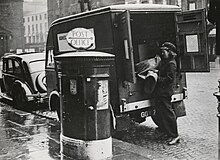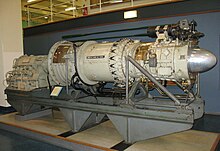Metropolitan-Vickers
Metropolitan-Vickers, Metrovick, or Metrovicks, was a British heavy
, was for most of the 20th century one of the biggest and most important heavy engineering facilities in Britain and the world.History



Metrovick started as a way to separate the existing
In May 1917, control of the holding company was obtained jointly by the
The immediate post-war era was marked by low investment and continued labour unrest. Fortunes changed in 1926 with the formation of the Central Electricity Board which standardized electrical supply and led to a massive expansion of electrical distribution, installations, and appliance purchases. Sales shot up, and 1927 marked the company's best year to date.
On 15 November 1922 the BBC was registered and the BBC's Manchester station, 2ZY, was officially opened on 375 metres transmitting from the Metropolitan Vickers Electricity works in Old Trafford.
In 1921, they bought a 9-acre (3.6 ha) site at Attercliffe Common in Sheffield, which was used to manufacture traction motors. By 1923, it had its own engineering department, and was making complete locomotives and electric delivery vehicles.[5]
BTH merger and transition to AEI
In 1928 Metrovick merged with the rival British Thomson-Houston (BTH), a company of similar size and product lineup. Combined, they would be one of the few companies able to compete with Marconi or English Electric on an equal footing. In fact the merger was marked by poor communication and intense rivalry, and the two companies generally worked at cross purposes.
The next year the combined company was purchased by the
Problems worsened in 1929 with the start of the
During the 1930s Metropolitan Vickers produced two dozen very large diameter (3m/10 ft) three-phase AC traction motors
In 1935 the company built a 105
In 1936 Metrovick started work with the Air Ministry on automatic pilot systems, eventually branching out to gunlaying systems and building radars the next year. In 1938 they reached an agreement with the Ministry to build a turboprop design developed at the Royal Aircraft Establishment (RAE) under the direction of Hayne Constant. It is somewhat ironic that BTH, its erstwhile partners, were at the same time working with Frank Whittle on his pioneering jet designs.
Wartime aircraft production

In mid-1938, MV was awarded a contract to build
In 1940 the turboprop effort was re-engineered as a pure jet engine after the successful run of Whittle's designs. The new design became the
In addition to building aircraft, other wartime work included the manufacture of both Dowty and Messier undercarriages, automatic pilot units, searchlights and radar equipment. They also produced electric vans and lorries.
Metrovick postwar


The post-war era led to massive demand for electrical systems, leading to additional rivalries between Metrovick and BTH as each attempted to one-up the other in delivering ever-larger turbogenerator contracts. Metrovick also expanded its appliance division during this time, becoming a well known supplier of refrigerators and stoves.
The design and manufacture of sophisticated scientific instruments, such as
In 1947, a Metrovick G.1 Gatric
The Bluebird K7 jet-propelled 3-point hydroplane in which Donald Campbell broke the 200 mph water speed barrier was powered with a Metropolitan-Vickers Beryl jet engine producing 3,500 lbf (16 kN) of thrust. The K7 was unveiled in late 1954. Campbell succeeded on Ullswater on 23 July 1955, where he set a record of 202.15 mph (325.33 km/h), beating the previous record by some 24 mph (39 km/h) held by Stanley Sayres.
Another major area of expansion was in the diesel locomotive market, where they combined their own generators and traction motors with third-party diesel engines to develop in 1950 the
Metropolitan Vickers also produced electrical equipment for the
In the 1950s, the company built a large
In 1961, the Russian cosmonaut Yuri Gagarin was invited to the company's factory at Trafford Park as part of his tour of Manchester.[14][15]
The rivalry between Metrovick and BTH was eventually ended in an unconvincing fashion when the AEI management eventually decided to rid themselves of both brands and be known as AEI universally, a change they made on 1 January 1960. This move was almost universally resented within both companies. Worse, the new brand name was utterly unknown to its customers, leading to a noticeable fall-off in sales and AEI's stock price.
General Electric Company (GEC) takeover
When AEI attempted to remove the doubled-up management structures, they found this task to be even more difficult. By the mid-1960s the company was struggling under the weight of two complete management hierarchies, and they appeared to be unable to control the company any more. This allowed AEI to be purchased by General Electric Company in 1967.
See also
- Category:Metropolitan-Vickers locomotives
- Bowesfield Works
- Metro-Vickers Affair
- Metrovick electric vehicles
References
- ^ a b c "History of Metropolitan Vickers Ltd" on British Telephones.com
- ^ a b c d Scott (1963). pp. 140–142.
- ^ a b c Gillham (1988), Chapter 2: The Manufacturers.
- ^ Scott (1963). Appendix A.
- ^ "Attercliffe Works". Science Museum Group. Archived from the original on 14 July 2021.
- ^ "V40 traction motor". Archived from the original on 22 February 2010. Retrieved 3 July 2011.
- ^ "Turbine, Battersea Power Station, 31 January 1935"
- ^ Nunn, Robert H (25 February 1977). "The Marine Gas Turbine" (PDF). Office of Naval Research. Archived (PDF) from the original on 19 April 2021.
- Diesel Railway TractionSeptember 1954 page 219
- ^ Type 2 Co-Bo Diesel-Electric Locomotives for LMR The Railway Magazine issue 693 January 1959 page16
- ^ Farewell to the Metro-Vick Co-Bos Railway World issue 433 January 1969 page 16
- ^ Australia's Most Powerful Locomotives for Work on Steep Mountain Grades Railway Transportation August 1956 page 26
- ^ Electric Rolling Stock for Manchester-Glossop Service Railway Gazette 9 July 1954 page 41
- ^ ""Yuri Gagarin in the UK"". Archived from the original on 10 October 2011. Retrieved 12 July 2011.
- ^ ""Yuri Gagarin's visit to Manchester"". Archived from the original on 14 March 2011. Retrieved 12 July 2011.
Bibliography
- Scott, J. D. (1963). Vickers: A History. London: Weidenfeld & Nicolson.
- Gillham, J. C. (1988). The Age of the Electric Train: Electric trains in Britain since 1883. London: ISBN 0-7110-1392-6.
External links
- "Metropolitan-Vickers Electrical Co. Ltd. 1899-1949" by John Dummelow 250 pages of text and pictures. (This is a mirror of the original, which was accessed from https://web.archive.org/web/20050308065049/http://www.mvbook.org.uk/ )
